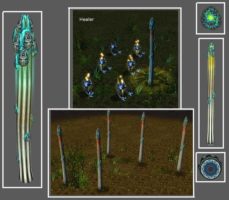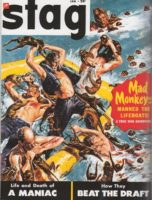by Charles Lear
 In the world of UFOlogy, some stories continue on, even after they’ve been convincingly debunked. This is often due to a particular story’s entertainment value and, it should be remembered, many UFO stories exist in an area between fiction and fact. If we were to assign this area a genera name, perhaps “true science fiction” might be appropriate. The idea that a fantastic story could be true, makes the story that much more interesting and suspension of disbelief is something everyone engages in when they want to be entertained. One such story, a biographical tale under the byline, Fred Reagan, appeared in the May 1953 issue of Action magazine. It could be held up as an example of what many paranormal enthusiasts call, “high strangeness.” However, it seems to be what folklorists call, “a tall tale.”
In the world of UFOlogy, some stories continue on, even after they’ve been convincingly debunked. This is often due to a particular story’s entertainment value and, it should be remembered, many UFO stories exist in an area between fiction and fact. If we were to assign this area a genera name, perhaps “true science fiction” might be appropriate. The idea that a fantastic story could be true, makes the story that much more interesting and suspension of disbelief is something everyone engages in when they want to be entertained. One such story, a biographical tale under the byline, Fred Reagan, appeared in the May 1953 issue of Action magazine. It could be held up as an example of what many paranormal enthusiasts call, “high strangeness.” However, it seems to be what folklorists call, “a tall tale.”
According to the article, Reagan was flying his Piper Cub over Georgia. A pulsating lozenge-shaped object came into his airspace and he collided with it. Reagan was thrown from his plane and started falling through the air. Then, a “sticky, clinging force” grabbed him and pulled him up toward the UFO.
 He found himself inside a dimly lit room surrounded by strange beings. They were around three feet tall and resembled “huge stalks of metallic asparagus.” He lost consciousness. When he came to, a metallic voice spoke to him through a speaker. Using broken English, the voice apologized for the collision, saying it had been an accident. It explained they were here to observe our primitive civilization and that their mission was peaceful. The voice further told him that they’d examined him and found a cancerous tumor, which they “adjusted.” He was instructed not to talk about the incident, as no one would believe him.
He found himself inside a dimly lit room surrounded by strange beings. They were around three feet tall and resembled “huge stalks of metallic asparagus.” He lost consciousness. When he came to, a metallic voice spoke to him through a speaker. Using broken English, the voice apologized for the collision, saying it had been an accident. It explained they were here to observe our primitive civilization and that their mission was peaceful. The voice further told him that they’d examined him and found a cancerous tumor, which they “adjusted.” He was instructed not to talk about the incident, as no one would believe him.
He then woke up in a hospital. He was told he’d been found in a farmer’s field. The wreckage of his plane was nearby and had struck with such force that the engine was buried six feet into the ground. Reagan wasn’t even scratched.
The article carried the following postscript:
Atlanta-May 16. Fred Reagan, who made headlines last year when he claimed to have been a visitor aboard a flying saucer, died today in the State Asylum for the Insane.
Cause of death was determined to be degeneration of brain tissue due to extreme atomic radiation. Authorities are unable to offer an explanation.
The story turned up later in the September-October 1969 issue of Flying Saucer Review. In his article, “Healing From UFOs,” Gordon Creighton tells the reader that the account came to the attention of Derek Dempster, who was the editor of FSR from January 1955 to June 1956. According to Creighton, Dempster and subsequent editors failed to publish the account “no doubt because in those days it seemed altogether too preposterous and fantastic to be true.” Creighton suggests that the story deserves further scrutiny.
The story was taken up by Patrick Huyghe and appears in his 1996 book, “The Field Guide to Extraterrestrials,” despite its having been debunked over two decades earlier. Jerome Clark includes the story in his 2003 book, “Strange Skies: Pilot Encounters With UFOs,” and describes its debunking. According to Clark, Canadian researcher Kurt Glemser made a search of Georgia’s Vital Records Unit in 1972. He found no clipping that matched the one carried in the postscript. He also found no record of a Fred Reagan who’d been involved in an aerial collision with a UFO. T. Scott Crain also did extensive research and found nothing to support the story. He concluded that the story “appears to be the ramblings of a ghost writer’s vivid imagination.”
 The old maxim, “consider the source,” certainly applies here. In this case, the source was a pulp magazine directed towards a male audience. In the 1950s, there were many of these on the newsstands filled with tales of adventures. The stories had titles such as, “Cannibal Crabs Crawl To Kill” and, “Mad Monkeys Manned The Lifeboats!” along with lurid artwork on the cover. With no other record of the incident in question, it can be assumed with confidence that the story was made up.
The old maxim, “consider the source,” certainly applies here. In this case, the source was a pulp magazine directed towards a male audience. In the 1950s, there were many of these on the newsstands filled with tales of adventures. The stories had titles such as, “Cannibal Crabs Crawl To Kill” and, “Mad Monkeys Manned The Lifeboats!” along with lurid artwork on the cover. With no other record of the incident in question, it can be assumed with confidence that the story was made up.
 Despite its debunking, this tale didn’t completely disappear into obscurity. It lives on and the creatures have become known as, “The Georgia Stalks.” The Stalks show up on the web in forum posts and as part of a list of bizarre non-grey aliens reported over the years. In addition to the written descriptions, there’s an informative video for all those YouTube researchers out there. It’s an example of the type of story that can confuse students of UFOlogy that are new to the subject. One could think of it as a test challenge to help develop research skills. One could also think of it as an entertaining example of modern folklore.
Despite its debunking, this tale didn’t completely disappear into obscurity. It lives on and the creatures have become known as, “The Georgia Stalks.” The Stalks show up on the web in forum posts and as part of a list of bizarre non-grey aliens reported over the years. In addition to the written descriptions, there’s an informative video for all those YouTube researchers out there. It’s an example of the type of story that can confuse students of UFOlogy that are new to the subject. One could think of it as a test challenge to help develop research skills. One could also think of it as an entertaining example of modern folklore.